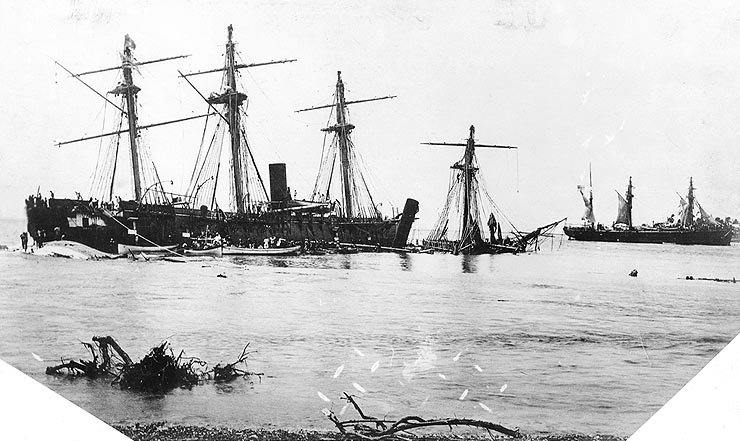Today in History - March 16
• King Alexander III falls from horse and dies
• Progressive Swedish king Gustavus III assassinated
• Samoan Civil War ends with wrecked ships of three nations
-- Compiled by James Finlayson-Bald
 After the Samoan Crisis (1889) at the end of the Samoan Civil War, a scene of wrecked ships in Apia Harbor, Upolu, Samoa, during salvage efforts soon after the hurricaine hit during the crisis. The view looks about northward, with USS Trenton and the sunken USS Vandalia to the left and the beached German corvette Olga at right.
After the Samoan Crisis (1889) at the end of the Samoan Civil War, a scene of wrecked ships in Apia Harbor, Upolu, Samoa, during salvage efforts soon after the hurricaine hit during the crisis. The view looks about northward, with USS Trenton and the sunken USS Vandalia to the left and the beached German corvette Olga at right.
Wreckage just off Trenton's stern may be from the German gunboat Eber, which was destroyed when she struck the harbor reef during the hurricane.
On this date:
1285—King Alexander III of Scotland died after a fall from his horse, in the dark, while riding to visit the Queen at Kinghorn.
1713—The Asiento Treaty was signed giving the British exclusive rights to supply the Spanish colonies with slaves, 144,000 at the rate of 4800 a year for a thirty year period. This privilege was conveyed by the British government to the South Seas Company, formed to work it. This unhappy act formed the solid basis of the speculative fever called the "South Seas Bubble."
1792—Gustavus III, King of Sweden, was assassinated. One of the outstanding 18th century monarchs, he was also an author and playwright of note, he is said to have created the Swedish theatre. The Peace of Varala he concluded with the Empress Catherine of Russia defused a situation dangerous to Sweden and brought a subsidy from Russia of 30,000 roubles a year. Sadly he fell a victim to a widespread aristocratic conspiracy and was shot in the back by Baron Anckarstrom at a midnight masquerade at the Stockholm Opera House.
1889—The final act in the Samoan Civil War. The Germans had declared a state of war against the British and Americans. In the tiny harbour at Apia lay three American warships, Nipsic, Vandalia, and Trenton; three German, Adier, Eber, and Olga; one British, Calliope, plus six merchantmen and a number of small craft, all crowded into a harbour in which it was estimated that only four vessels could safely manoevure. The previous day the barometer fell to 29.11 in. by 2pm, the last safe moment for the ships to put to sea. Trenton stubbornly refused to leave and the Germans sat there glowering at her. By six in the morning (the 16th) a hurricane was blowing directly into the harbour. Eber had sunk and the other vessels were massed together inflicting damage one upon the other. Nipsic had lost her smokestack and was maintaining her fire with barrels of pork. At 8am the master of the Adler managed to drive her onto the summit of the reef thus saving her crew. The British Calliope now attempted and succeeded in leaving the harbour, proceeding at one sea mile an hour. The master of Nipsic had beached her alongside Olga but Vandalia was crushed by Trenton. Thus in one day the symbol of European power was completely destroyed leaving a band of unarmed, anxious castaways stranded on a Pacific beach.
Today's birthdays:
George Ohm, physicist, (1787-1854).
Maxim Gorky, novelist (1868-1936).
Thought for today:
Ichabod!
The above article was written by James Finlayson-Bald.
Edited and illustrations added by David Paul Wagner.
|
